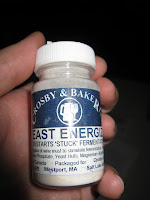Exciting stuff, today the SG of the wine must is 1.006 which means it's time to rack into a cleaned and sanitized carboy (again Oxiclean for cleaning, rinsed well, and K-meta and water for sanitizing). I removed the grape skin bag and squeezed it gently to remove as much of the liquid as possible. The bag is then discarded as it has no further use.
I then cleaned my auto-siphon and sanitized it as well. Here's the start of the siphon. The idea here is to take the bulk of the wine must and move it into the carboy which is then put under air lock so no oxygen gets into it. As fermentation slows, the production of CO2 lowers and allows for air to get inside the must and cause bacterial growth and oxidization.
I also took an acidity reading today and found that the wine is 0.675 % (0.675 grams acid per 100 mL) which is well within the normal range for a dry red wine.
Below you can see the auto siphon placed into the wine. I placed the bottom up against the side of the bucket, about 2 inches above the bottom so as to not to bring the bulk of the sediment along with the liquid.
Here it is all done. What's left on the bottom is a tiny bit of liquid and the sediment which includes live yeast, dead yeast, oak shavings and anything else that was heavy and brought to the bottom of the bucket by gravity with the help of the bentonite added on day 1.
And here it is. I cleaned and sanitized an airlock and filled it halfway with water. This airlock allows air to escape (CO2 that's being produced by the secondary fermentation) but keeps oxygen from coming back into the bottle. It bubbles about once every 2-3 seconds which means it's working away nicely.
The wine will sit in this carboy for about 10 days before receiving a treatment that will stop the yeast from reproducing and will halt fermentation. The idea is that the specific gravity gets to about .996 or below before I move on.
And as if this day wasn't exciting enough, it's time to put the yeast slurry (the left over lees that you see in the bottom of the bucket after the wine was racked) to work.
Because there's some very good wine yeast in there with plenty of pep left, people have developed a great recipe for a lemon wine that's about 10% alcohol and drinks like a true hard lemonade (and not a flavored malt beverage like Mike's- nasty.)
It's a great summer drink, but why let the yeast slurry go to waste! I'll be putting it to use right away. The first step is to take 16 cups (YES! 16 CUPS!) of sugar and dissolve it into 8 cups of water. You then create invert sugar by heating it just before boil and leaving it at that temperature for 30 minutes. This breaks the sugar down into glucose and fructose. I also added 1/3 a cup of real lemon concentrate because the acid helps facilitate the process.
Then I mixed 64 ounces of the real lemon concentrate with about a half gallon of cool water and placed it into the clean and sanitized fermenting bucket. as seen below- (try to guess why it's called skeeter pee?)
After that you take the invert sugar and pour it into the bucket and fill to 5.5 gallons with filtered water:
After that it's time to add 3/4 tsp of tannin, 1 tsp of yeast energizer (which helps kick start fermentation) and 3 tsp of yeast nutrient (feed those yeast!)
This concoction sits in the bucket with a towel over it for about 24 hours before adding in the yeast slurry that I removed from the bucket and placed in the refrigerator to keep until tomorrow.
That's all for today. PHEW- that was enough, I think!











No comments:
Post a Comment